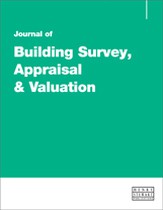Bridging the performance gap: Understanding predicted and actual building operational energy
Abstract
Buildings rarely perform as well as their designers predict — energy consumption can be as much as double what was expected, so annual energy costs can also be doubled. This difference has become known as the ‘performance gap’; in some cases it is due to more intensive or extended occupancy, but often the major cause is that the building services are operated inefficiently and not as intended by the designers. The ‘performance gap’ is difficult to quantify because the performance ratings obtained from energy certificates at design stage and in use are, amazingly, not directly comparable. The two seemingly irreconcilable indicators of performance available are energy performance certificates, (EPCs), which provide a theoretical assessment of their asset but under standardised ‘driving conditions’, and operational ratings, which are based on energy bills and give no indication of how much lower those bills could be. The operational rating is nearly always higher due to non-standard hours of operation, occupancy patterns and unregulated loads, such as IT and office equipment. To truly understand how a building uses energy it is necessary to know something about the building itself and about how it is used; this requires both an asset rating and an operational energy rating. Bridging the Performance Gap — Understanding Predicted and Actual Building Operational Energy looks at ways of bringing the two assessments together. The UK Government's Green Deal assessment process (GD-SBEM) provides, for the first time, a tool to reconcile these pieces of information, which ties in with the requirements of the UK Government's ‘Energy Savings Opportunity Scheme’ (ESOS).1 The Green Deal (GD) tool can also be used to identify energy savings and to produce the data to underpin any business case for investment in energy efficiency measures.
The full article is available to subscribers to the journal.
Author's Biography
Andy Lewry DIC, CEng, CSci, FIMMM, CEnv, MSocEnv, FEMA has 19 years’ varied technical, marketing and management experience within the carbon and energy management industry, preceded by a further 10 years’ similar experience within various parts of the environmental and construction sectors. Andy is a chartered engineer and a Fellow of both the Institute of Materials (IOM3) and the Energy Managers’ Association, as well as a Prince 2 qualified project manager. He is currently the principal technical consultant for the BREEAM Existing Buildings Team in BRE Global. Andy has authored and published best practice publications on energy management, energy audits, building control and building energy management systems. Recently he produced guidance on ‘Bridging the performance gap: Understanding predicted and actual energy use of buildings’, Journal of Building Survey, Appraisal & Valuation, Vol. 3, No. 4, and ‘Producing the business case for investment in energy efficiency’, Journal of Building Survey, Appraisal & Valuation, Vol. 4, No. 1. He was also part of the UK Green Building Council’s task group that produced the ‘Delivering Building Performance’ report on 11th May, 2016, which lays out the success factors and steps required to tackle the gap between building design and building performance.
Citation
Lewry, Andy (2015, February 1). Bridging the performance gap: Understanding predicted and actual building operational energy. In the Journal of Building Survey, Appraisal & Valuation, Volume 3, Issue 4. https://doi.org/10.69554/WHEM1824.Publications LLP
